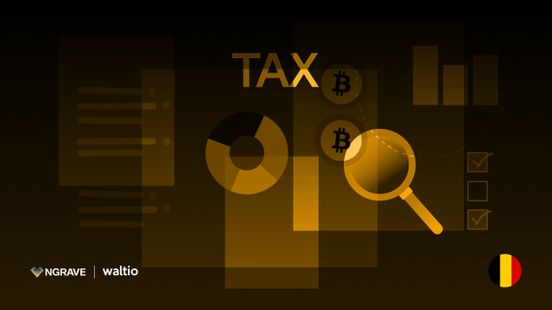

Blockchain Interoperability: Challenges & Opportunities
Blockchains offer a way to establish truth without needing trust. If these isolated chains get bridged, groundbreaking opportunities may come.
- Article Quick Links:
- 1. What is blockchain interoperability & why is it so important?
- 2. The interoperability trilemma
- 3. The different solutions for connecting blockchains
- 4. Beyond Bridges - eWASM & Multichains
- 5. The security challenge for blockchain bridges
- 6. Interoperability, Usability & Self-custody
- Watch the full panel discussion
- More info on The Coldest Wallet at PBWS
This article summarises a panel discussion from the 2022 Paris Blockchain Week Summit (PBWS), where NGRAVE’s CEO, Ruben Merre, was invited to share his views on Blockchain Interoperability - Challenges and Opportunities. PBSW featured 250 speakers drawn from the most influential builders, creators and investors in the blockchain space. Find the video of the panel discussion and more content at the end of this article.

Blockchains are one of the most exciting innovations of the digital age, offering a way to establish truth without the need for trust. But one of the consequences of their design is that blockchains exist as isolated domains, unaware of the world outside, so cannot directly communicate with each other. There are huge opportunities for bridging blockchains but huge challenges too. We’ll explore both in this article and see where the future of blockchain interoperability lies.
1. What is blockchain interoperability & why is it so important?
At its launch in 2009 Bitcoin was one of the earliest blockchain implementations, supporting a new form of internet money with the same name. Over time other blockchain designs and applications have emerged, with the total value of assets secured by blockchains now exceeding over $2trillion in value and Bitcoin’s share - known as Bitcoin Dominance - sitting at around 40%.
After Bitcoin, the largest share of crypto market capitalisation is held by Ethereum, accounting for about 19.5%. That still leaves another 40% of the entire blockchain ecosystem supported by a variety of other chains and that heterogeneity is only expected to increase.
Though there is demand for different blockchain designs, there is also growing demand from users to transact across blockchains, whether driven by the search for maximum yield or a desire to simply experience different applications. That demand has fuelled the search for ways to build bridges between blockchains, as, without interoperability, the growth of the blockchain ecosystem will be stifled. Unfortunately, building blockchains bridges is more difficult than in the physical world.
2. The interoperability trilemma - the major challenge to bridging blockchains
Blockchains function based on unique rules, known as protocols, which include a method for reaching consensus on the accuracy of transactions in a decentralised and secure manner. Verifying accuracy without trust.
But that consensus is only designed to work natively. As soon as you send a transaction outside of a blockchain it has no way of achieving that verification through its existing rules.
The same is true for communication between digital applications (dApps) that sit on top of blockchains - described as layer 2. dApps rely on their base chain (layer 1) for verification, but that shared layer cannot route transactions back and forth between supported dApps.
The primary solution for sending transactions between layers (L1-L1,L2-L2) is blockchain bridges.

Bearing in mind the fundamental requirement that a blockchain is decentralised and secure, a bridge would ideally possess three qualities:
- Trustless - maintaining the same level of security as the base chain
- Extensible - usable across multiple chains
- Data Agnostic - able to transfer any type of data supported by chains
Existing blockchain bridges are unable to satisfy all three of those traits. This is known as the interoperability trilemma. There is always some level of compromise.
3. The different solutions for connecting blockchains
Given the interoperability trilemma, the types of solutions that have emerged for connecting blockchains are workarounds; ways of trying to put a square peg into a round hole.
Trusted Blockchain Bridges
If you want to send funds from Ethereum’s mainnet over to Bitcoin there is no simple way of doing this because, in simple terms, the Bitcoin and Ethereum blockchains aren’t aware of each other.
You can conceptualise the problem by thinking about sending some goods over a very high wall to someone on the other side. Once you send it over there is no way to be sure the goods have been received. What you could do is employ someone to sit on the wall, a man-in-the-middle, to verify that the goods have been collected.
That solution is simple, yet requires the huge compromise of trusting the man-in-the-middle, bringing you back to the interoperability trilemma.
The most basic example of a trusted blockchain bridge is using a centralised exchange to convert your Ethereum over to Bitcoin, then following the process in reverse. It is inefficient, costly and requires trust in the exchange who in turn requires you to prove your identity and conform to a bunch of their rules.
The advent of decentralised exchanges provided a way to convert assets without trust but is a long way from providing seamless interoperability.
A more efficient way of bridging Bitcoin and Ethereum emerged with the concept of wrapped coins, which take exchanges out of the equation but still require a trusted intermediary known as a Custodian.
You send your native Bitcoin to a Custodian like Bitgo that locks it within their system, and mints an equivalent amount of wrapped Bitcoin (wBTC) which is an ERC-20 token supported by Ethereum, and sends that to you in its place. You can then use your wBTC within Ethereum dApps.
When you want your native Bitcoin back you return your wBTC to the Custodian who unlocks and returns your BTC. The process is relatively simple but requires explicit trust that the Custodian will fulfil their end of the deal.
Wrapping coins is one of several different approaches to bridge two blockchains that rely on external verification. But if you won’t compromise on trust you need to take a different route.
Trustless Blockchain Bridges
If we return to our wall analogy we can look at the approaches to achieving verification without requiring the man-in-the-middle.

Local Verification
One way to achieve verification in a two-party exchange without trust is for each side to take responsibility for verifying with their own counterparty. This would mean that each side of the wall has its own representative sitting on top that can verify the goods have been received.
This solves the need for trust and can work between any two domains but is asset-specific, so isn’t the magic bullet solution.
Native Verification
The alternative way of achieving trustless verification between two blockchains is for each chain to natively verify in the destination chain. Going back to our wall analogy this would mean having a team member over the side verifying the exchange.
In real terms, this requires Relay Clients that are created to specifically work with a specific Consensus Mechanism. You can exchange anything with the same counterparty, but the approach can’t be extended to a different blockchain, so again trips up on the trilemma.
4. Beyond Bridges - eWASM & Multichains
The problem of interoperability comes down to the way blockchains are designed with bridges as workarounds. There are other approaches that take a more fundamental approach to the problem. eWASM and Multichains are two examples.
Ethereum’s Move to eWASM
Ethereum is undergoing a fundamental change in 2022 (described as the Merge) moving from Proof of Work consensus mechanism to Proof of Stake, one of the primary main reasons being to improve scalability.
At the same time, there is a huge amount of innovation happening around layer 2 solutions to scalability, known as rollups. But even if Eth 2.0 and rollups are a huge success it is unrealistic to think that as a result of the Merge we will move to a single-chain world dominated by Ethereum. There is however a more fundamental change to the way Ethereum works that might meaningfully impact interoperability - eWASM.
At the heart of Ethereum’s computational engine is the Ethereum Virtual Machine, EVM for short. Ethereum developers argue that the EVM wasn’t built with real-world implementation in mind, focusing on purity rather than useability. It also supports only one script - Solidity. Their intention is to move away from EVM to something called eWASM, Ethereum’s version of web assembly code which brings the potential for far greater interoperability.
"I would make the case there wasn't an enormous amount of design thinking put into it at the beginning," Lane Rettig, an Ethereum developer.
If you want to get into the nitty-gritty of how eWASM will work Google is your friend, but a further quote from Rettig summarises the potential in relation to interoperability, which is what we are discussing here.

“eWASM will unlock new levels of interoperability as well. For one, it's built in a language that has been standardized for the World Wide Web, so adding in-browser support for an ethereum light client would be trivial. And it could pave the way for undiscovered interoperability between different blockchains as well. Maybe you have quadratic sharding over here, and Plasma over here, and maybe they overlap in places, and maybe we have a Dfinity chain talking to an ethereum chain talking to bitcoin through Cosmos and Polkadot," Rettig said
Though eWASM sounds like a potential solution to the interoperability trilemma not every Ethereum developer is a fan. Several point out that its reliance on Compilers provides its own point of a single point of weakness. That pesky trilemma never seems to go away.
Polkadot, Cosmos & Multichain Solutions
If the idea of a single chain to rule them all seems unrealistic there is another approach to interoperability that focuses on introducing a new foundational layer on which multiple blockchains can sit, exchanging any data through a single shared protocol.
The two most popular examples of the cross-chain approach - also known as layer 0 - are Polkadot and Cosmos.
Polkadot was founded in 2016 by Gavin Wood who was part of the team that created Ethereum. It achieves cross-chain support using a concept called heterogeneous sharding. This allows multiple chains to be customised for unique use cases to exchange data in parallel.
The foundational layer is known as the Relay Chain, providing consensus, security and enabling supported chains to communicate. The Relay Chain supports sovereign blockchains with their own designs and used cases known as Parachains, built using a framework called Substrate.
Parachains bid for slots on the Relay Chain through scheduled auctions, or simply rent support on a pay-as-you-go basis. The first auctions were live in December 2021 and the ecosystem of supported L1s is gradually growing.
Polkadot provides seamless interoperability across multiple chains through a tool called Cumulus, but that is only applicable in relation to its own ecosystem. In order for Polkadot to communicate with external chains it still needs to use bridges, so it doesn’t completely solve the problem of interoperability.
However, as its ecosystem grows the network effects of a federation of connected chains will become a powerful and appealing alternative to standalone blockchains.
Conceptually, Cosmos takes a similar approach to Polkadot. It offers an easy to use blockchain SDK that enables a project to quickly spin up a layer 1 chain. Cross-chain communication is through the IBC Protocol - Inter Blockchain Communication. This allows trustless data transfer between sovereign chains but relies on the Native bridging approach described above using Relays with verification happening at the destination.
Cosmos’ vision is to create the internet of blockchains but to realise that ambition it has to rely on a complex network of bridges and smart contracts that work with the IBC protocol and a foundational consensus mechanism, Tendermint, that is often criticised for not offering true decentralisation due to the limited number of validators.
5. The security challenge for blockchain bridges
There is a good reason that blockchains are built as walled gardens. It is the only way to provide the security and privacy that decentralisation demands. As soon as you create a bridge that connects to an isolated blockchain domain to let information in or out, it immediately becomes a point of weakness and vulnerability that bad actors will look to exploit.
In the short time that blockchain bridges have been available over $1.5bn in funds have been stolen from DEFI protocols with the majority in the three high-profile hacks.
Polygon - On August 8th 2021 the Poly Network, a cross-chain protocol was exploited for $600million. The largest DEFI hack at the time. The funds were stolen across Ethereum, BSC and Polygon Chains, but in a strange twist were later returned by the attacker.
Wormhole - On February 2nd 2022, the Wormhole token bridge was exploited for the loss of 120,000 Wrapped Ether (wETH) tokens valued at $326million.
Ronin - In late March 2022 the Ronin Network illustrated the security vulnerabilities of interoperability. Its bridge to Sky Mavis, the makers of the popular play-to-earn game Axie Infinity, was exploited for the loss of an eye-watering $625million in Ethereum and USDC when its multi-sig validator system for withdrawals was compromised.
It seems inevitable that exploits of blockchain bridges will continue to occur. There is simply too much opportunity that can be realised within DEFI from moving funds across chains and too many corners being cut in the rush to service that demand.
6. Interoperability, Usability & Self-custody
As much as the interoperability trilemma is an issue from an ideological perspective, mainstream crypto adopters are much more focused on usability. So, for blockchain bridges to be usable, users shouldn’t have to think about the process, which in the majority of cases is about swapping tokens.
Whether on a desktop or mobile device, that exchange needs to be as simple as a FIAT foreign exchange transaction, which isn’t the case right now simply because inputting addresses and networks is clumsy. The use of ENS type domains (the ability to give your wallet a memorable name) will help, while wallet design will certainly improve to reduce friction, but this has to happen without security being compromised.
A chain is only as strong as its weakest link, bridges link chains, so are the most obvious attack vector given that is where the greatest value sits, but at the user level connecting a wallet to a bridge is also a potential point of failure.
The NGRAVE ZERO shows how security, self-sovereignty and usability can be combined within a wallet. It provides military-grade hardware security, but with a touch-screen interface that uses QR codes, dispensing with the hassle of a USB cable connection.
As ever in crypto, education will need to play a key role in enabling the increased use of bridges without widespread theft of funds. Looking at the average internet user’s InfoSec you have to be concerned. In 2018 Google reported that only 10% of users implemented 2FA, suggesting that the growing numbers of users that want to access other chains for trading/gaming but might compromise on sovereignty in exchange for usability, happily accepting centralised bridging options.
In that sense, it might save a lot of hassle If there was only one blockchain, but in reality, we are moving to a more heterogeneous blockchain ecosystem, so we’ll continue to see innovation across the different potential solutions to bridging blockchains, as well as improving usability.
We are early in the game so MetaMask will make it easier and more intuitive for users to connect to multiple networks, while for hardware wallets like the NGRAVE ZERO the hardest part was producing a device that provides ultimate protection of a Seed.
Adding support for more blockchains incurs a low marginal cost, but there is an additional marginal security risk each time software needs updating. NGRAVE has anticipated that by providing the highest possible security for software updates (EAL-7).
So though for now communicating directly between blockchains requires imperfect solutions, NGRAVE is focused on enabling users to retain sovereignty and control of their funds up to the point where they then decide to cross a bridge from one chain to another.
Watch the full panel discussion
NGRAVE’s CEO, Ruben Merre, was invited to the Blockchain Interoperability - Challenges and Opportunities panel discussion at the 2022 Paris Blockchain Week Summit (PBWS).
More info on The Coldest Wallet at PBWS
KITCO is a global business news network focusing on metals and crypto. During PBWS 2022, they interviewed Ruben Merre for his point of view on crypto security and to explain how NGRAVE protects crypto investors.
Article Quick Links:
- 1. What is blockchain interoperability & why is it so important?
- 2. The interoperability trilemma
- 3. The different solutions for connecting blockchains
- 4. Beyond Bridges - eWASM & Multichains
- 5. The security challenge for blockchain bridges
- 6. Interoperability, Usability & Self-custody
- Watch the full panel discussion
- More info on The Coldest Wallet at PBWS

Ruben is a repeat tech entrepreneur. His focus is on digital asset security and financial empowerment. He is co-founder and CEO of NGRAVE, the creator of “ZERO” - the world’s most secure hardware wallet for crypto storage. In 2021, he was selected for Belgium’s 40 under 40. Before that, he was a finalist in scale-ups.eu’s Disruptive Innovator of the Year 2020 Award, and nominated in Google/PWC/Trends’ Digital Pioneer 2020.

